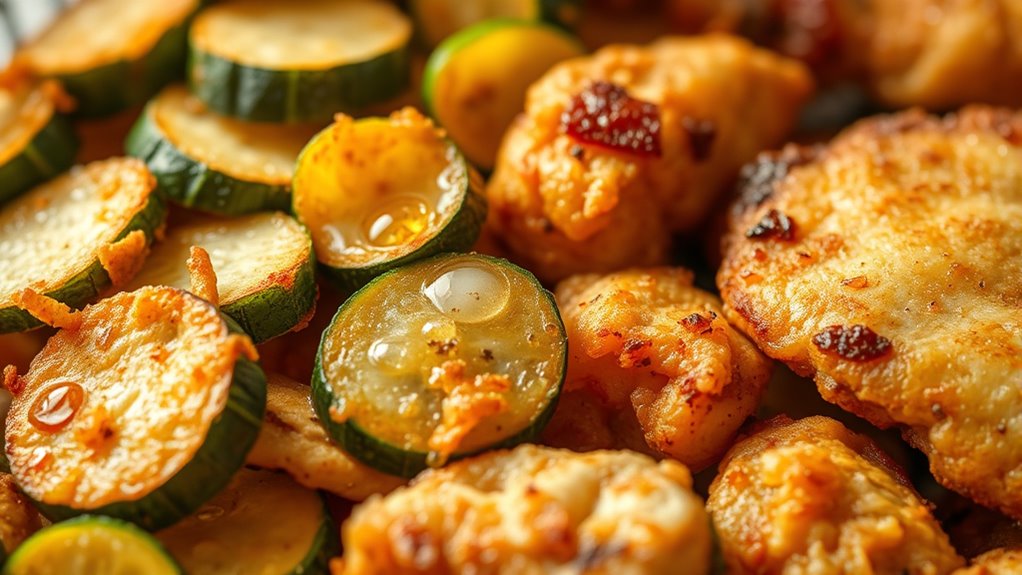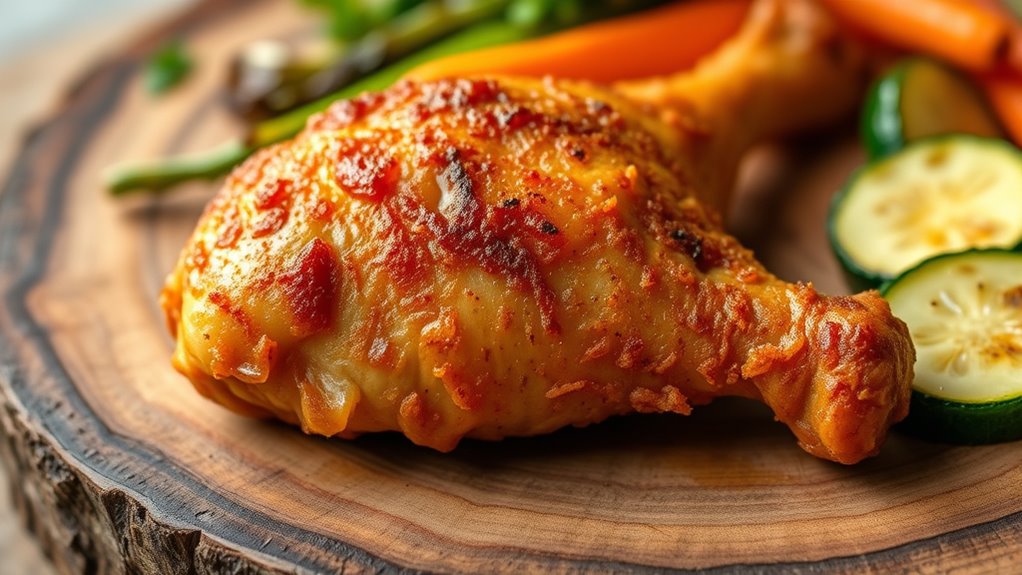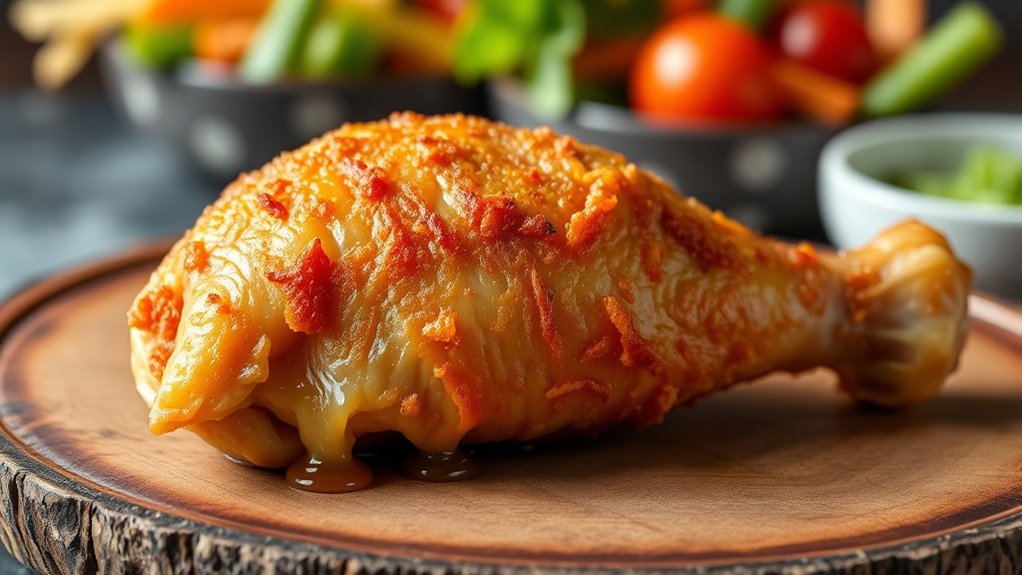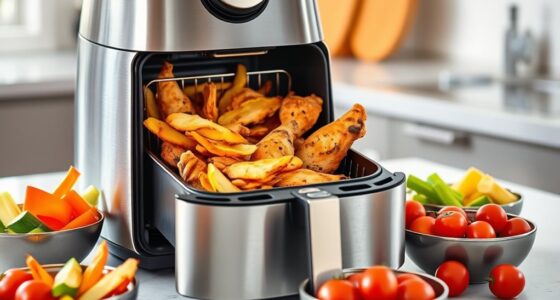Air frying reduces fat content in foods by using hot air instead of oil, which means you need less or no oil at all. Compared to deep frying, air-fried foods absorb much less oil, making them healthier and lower in calories. The amount of fat also depends on the food type, portion size, and cooking methods. If you want to learn how to make the most of this healthier cooking method, keep exploring the details below.
Key Takeaways
- Air frying uses hot air circulation, reducing the need for added oils and lowering overall fat content.
- Foods cooked in air fryers absorb significantly less oil compared to deep-fried counterparts, decreasing fat levels.
- Food type and preparation, such as breading or marinating, influence the amount of fat retained during air frying.
- Proper cooking techniques and minimal oil use help optimize lower fat content in air-fried foods.
- Choosing lean ingredients and avoiding heavy coatings further reduces the fat content of air-fried meals.
Understanding Air Frying and Fat Reduction

Since air frying uses hot air circulation instead of submerging food in oil, it notably reduces the amount of added fat needed for cooking. You can enjoy crispy textures without the excess oil that traditional frying requires. The process relies on rapid hot air movement to cook food evenly, creating a browned exterior. Because you’re not immersing food in oil, you naturally use less fat, which lowers overall calorie intake and makes meals healthier. This method also minimizes the absorption of oil into your food, helping you cut down on unnecessary fats. Additionally, choosing healthy cooking methods like air frying supports better nutritional habits by reducing fat consumption. As a result, air frying offers a convenient way to prepare your favorite dishes with considerably less added fat, making it easier to maintain a balanced diet without sacrificing flavor or texture.
Comparing Fat Content: Air Frying vs. Deep Frying

When comparing fat content, air frying typically results in considerably less fat in your food than deep frying. This is because air fryers use hot air circulation instead of submerging food in oil. As a result, you need only a small amount of oil or sometimes none at all, reducing the overall fat absorbed by your food. In contrast, deep frying involves immersing food fully in hot oil, leading to higher fat absorption. Even if you use oil in air frying, the amount is markedly less than what deep frying requires. Additionally, cleaning and maintenance of air fryers are generally easier due to less oil residue, contributing to a healthier cooking process. Proper oil management also plays a role in minimizing fat content during air frying. Using an air fryer can also help reduce the risk of lizard infestation around cooking areas by minimizing greasy residues and odors. Moreover, choosing the right cooking techniques can further decrease unhealthy fat intake. Consequently, air-fried foods generally contain fewer calories and less unhealthy fat. This makes air frying a healthier choice for those looking to cut back on fat intake without sacrificing flavor or texture.
Types of Foods and Their Fat Profiles

Different types of foods have distinct fat profiles that impact your health. Lean cuts generally contain less fat, while fattier cuts add more calories and saturated fats. Also, breaded foods tend to absorb more oil, increasing their fat content compared to unbreaded options. Incorporating essential oils for health in your diet or lifestyle may provide additional benefits. Being aware of the fat content in various foods can help you make healthier choices and manage your overall fat intake effectively. Monitoring flushing mechanisms and understanding how different foods influence the environment can further support sustainable and health-conscious decisions. Additionally, understanding symptoms of breast cancer can be crucial for early detection and better health outcomes.
Lean vs. Fatty Cuts
Understanding the fat profiles of different foods is essential when choosing air-fried options, as some cuts naturally contain more fat than others. Lean cuts, like chicken breast or sirloin, have minimal fat and produce healthier results. Fatty cuts, such as pork belly or ribeye, contain higher fat content, which can add flavor but also more calories. When selecting meats, consider your dietary goals and how much fat you want to reduce.
- Lean cuts are lower in saturated fat, aiding heart health
- Fatty cuts offer richer flavor and juiciness
- Trim excess fat from fatty meats to cut calories
- Opt for lean options for a healthier, lighter meal
Breaded vs. Unbreaded
Choosing between breaded and unbreaded foods can substantially impact the fat content of your air-fried meals. Breaded options typically absorb more oil and fat during cooking due to the coating, resulting in higher fat levels. Unbreaded foods, like plain chicken or vegetables, tend to retain less fat, making them healthier choices. The table below compares typical fat contents:
| Food Type | Approximate Fat Content (per serving) |
|---|---|
| Breaded Chicken | 8-12 grams |
| Unbreaded Chicken | 3-5 grams |
| Breaded Fish | 6-10 grams |
| Unbreaded Fish | 2-4 grams |
Additionally, oil absorption during air frying can vary based on food preparation methods, influencing overall fat content.
The Impact of Cooking Oils on Fat Levels

The type of cooking oil you choose can substantially affect the fat content of your air-fried foods. Some oils absorb more easily, increasing the overall fat levels, while others stay minimal. Understanding oil absorption rates helps you make healthier choices for your meals. Additionally, selecting oils with lower vulnerability to heat-induced degradation can help maintain their nutritional profile and reduce the formation of harmful compounds during cooking. Using healthy fats in moderation can also support overall dietary balance and health. Being mindful of the oil absorption rate can further assist in controlling calorie intake and promoting a balanced diet. Incorporating tuning principles like optimal oil temperature can also influence how much oil the food absorbs during air frying.
Types of Cooking Oils
Have you ever wondered how the type of cooking oil you use can influence the fat content in your air-fried foods? Different oils have varying fat profiles and smoke points, which can affect both health and flavor. Choosing healthier oils, like olive or avocado, can reduce saturated fats and increase beneficial monounsaturated fats. Some oils, such as coconut oil, contain more saturated fats, impacting calorie levels. The oil’s composition also influences how it interacts with your food during cooking. Additionally, understanding the 16PF traits of different oils can help in selecting the most suitable option for your dietary needs. Being aware of the drivetrain components of your chosen oils can help optimize cooking performance and health benefits. Knowing the nutritional profile of various oils assists in making informed choices to align with your dietary goals. The chemical properties of each oil also determine how they behave under heat, affecting both flavor and nutritional retention.
Oil Absorption Rates
Ever wonder how much oil your air-fried foods actually absorb during cooking? Oil absorption rates vary based on the type of oil and food texture. Typically, foods absorb between 5% and 15% of their weight in oil. For example, crispy chicken might soak up more oil than vegetables. Factors like cooking temperature and duration influence absorption too. To give you a clear picture, here’s a quick comparison:
| Food Type | Oil Absorption Rate | Impact on Fat Content |
|---|---|---|
| Vegetables | 5-8% | Minimal increase |
| Lean Proteins | 8-12% | Moderate increase |
| Battered Foods | 12-15% | Significant increase |
Understanding these differences helps you control fat levels in your air-fried meals. Additionally, oil quality can also affect how much oil is absorbed during cooking, influencing the final fat content. Proper cooking techniques can further minimize excess oil absorption and promote healthier eating. Recognizing how oil absorption varies among different foods allows for better meal planning and healthier choices. For instance, food texture plays a crucial role in determining how much oil is retained during frying or air frying.
How Portion Sizes Affect Fat Intake

Portion sizes play a essential role in determining your fat intake from air-fried foods. When you eat larger servings, you naturally consume more calories and fat, even if the cooking method is healthier. Overestimating portion sizes can lead to unintended weight gain and higher saturated fat intake. Conversely, controlling your portions helps you enjoy air-fried foods without overdoing it.
Controlling portion sizes helps enjoy air-fried foods without excess calories or fat.
Consider these points:
- Larger portions increase overall fat consumption
- Smaller servings help manage calorie intake
- Plate size influences portion perception
- Mindful eating prevents overeating
- Using appropriate serving sizes can further help regulate fat and calorie intake.
- Paying attention to heat pump noise levels can improve overall comfort during meal prep, especially when cooking involves longer durations.
Tips for Minimizing Fat in Air Fried Meals

To minimize fat in air-fried meals, start by choosing lean protein sources and trimming excess fat before cooking. This reduces the overall fat content from the beginning. Use minimal or no added oils; instead, rely on cooking sprays or brushes with small amounts of healthy oils like olive or avocado oil. Incorporate flavorful herbs, spices, and citrus to enhance taste without extra fat. When preparing vegetables or proteins, opt for marinades or seasonings that don’t contain high-fat ingredients. Avoid breading or battering foods heavily, as these can increase fat and calorie content. Instead, use light coatings like panko or crushed nuts in moderation. By making these small adjustments, you can enjoy delicious air-fried meals with less fat and healthier benefits.
Reading Labels and Nutritional Information

Reading labels and nutritional information is essential for making healthier choices when selecting air-fried foods. By paying attention to packaging, you can identify options with lower fat content and avoid hidden calories. Check serving sizes to ensure you’re not overestimating portion amounts, and look for foods labeled as “reduced fat” or “healthy.” Be aware that some products may contain added sugars or preservatives that can impact overall health. Comparing nutrition labels helps you find better options tailored to your goals. Understanding ingredient lists can also reveal the types of fats used, such as trans fats or unhealthy oils. Staying informed enables you to make smarter decisions and enjoy air-fried foods without compromising your health.
- Recognize serving size and calories per serving
- Identify added sugars and preservatives
- Compare fat types and amounts
- Look for healthier product labels
Making Healthier Choices With Air Fryer Recipes

By choosing healthier ingredients and cooking techniques, you can considerably reduce the fat content in your air fryer recipes. Swap out breaded or battered foods for fresh, whole ingredients like vegetables, lean meats, or fish. Use minimal oil—just a light spray or brush—to achieve crispiness without excess fat. Incorporate herbs, spices, and citrus for flavor instead of high-fat sauces or marinades. Opt for cooking methods like roasting or grilling in your air fryer to enhance natural flavors while keeping fat levels low. Adjust recipes by reducing or eliminating added fats and avoid pre-packaged, processed foods high in unhealthy oils. These simple changes help you enjoy delicious, crispy meals with considerably less fat, supporting your health and wellness goals.
Frequently Asked Questions
Does Air Frying Completely Eliminate Fat From Foods?
You wonder if air frying completely eliminates fat from foods. While air frying uses considerably less oil than traditional frying, it doesn’t remove all the fat naturally present in ingredients. Some fats are inherent to the food itself and remain after cooking. So, although air frying reduces added fats, it doesn’t totally eliminate fat content. You still get some fat, just in smaller amounts, making it a healthier alternative overall.
Can Air Frying Reduce Trans Fats in Processed Foods?
You’re wondering if air frying can reduce trans fats in processed foods. While air frying doesn’t eliminate trans fats entirely, it can help you cut back by using less or no added fats during cooking. Processed foods often contain trans fats from their ingredients, and air frying’s ability to cook with minimal oil means you consume less of these unhealthy fats. It’s a healthier way to enjoy your favorite snacks.
How Does the Type of Food Affect Its Fat Absorption During Air Frying?
Imagine you’re in the 21st century, asking how food type impacts fat absorption during air frying. You’ll find that foods high in natural fats, like bacon or cheese, tend to absorb more oil, even with little added. Conversely, lean meats or vegetables absorb less. The food’s moisture content and surface texture also influence fat uptake, so choosing items wisely helps you maintain healthier results when air frying.
Are There Specific Brands of Air Fryers Better for Fat Reduction?
When choosing an air fryer for fat reduction, you should look for models with adjustable temperature controls and multiple cooking settings. Brands like Philips and Ninja often offer advanced features that help you control fat absorption better. You might also want to take into account models with a basket that allows excess fat to drain away. Ultimately, selecting a reputable brand with good reviews guarantees you get a device that supports healthier cooking.
What Is the Best Way to Measure Fat Content in Air-Fried Leftovers?
To measure the fat content in your air-fried leftovers, you can use a digital food scale to weigh the food before and after cooking, then analyze the difference. Alternatively, you might use a laboratory testing service for precise results, but that’s less practical. For everyday purposes, estimating based on raw ingredients and cooking methods gives you a good idea of fat reduction. Always remember, draining excess fat can also help lower overall fat intake.
Conclusion
Choosing air frying over traditional methods is like planting seeds of health in your kitchen. Each mindful choice you make reduces unnecessary fat, nurturing your well-being. Remember, the air fryer is your compass guiding you away from excess and toward balance. Embrace this tool as a symbol of your journey—where small, healthy steps blossom into a vibrant, healthier life. Your mindful decisions today shape the wellness of tomorrow.









